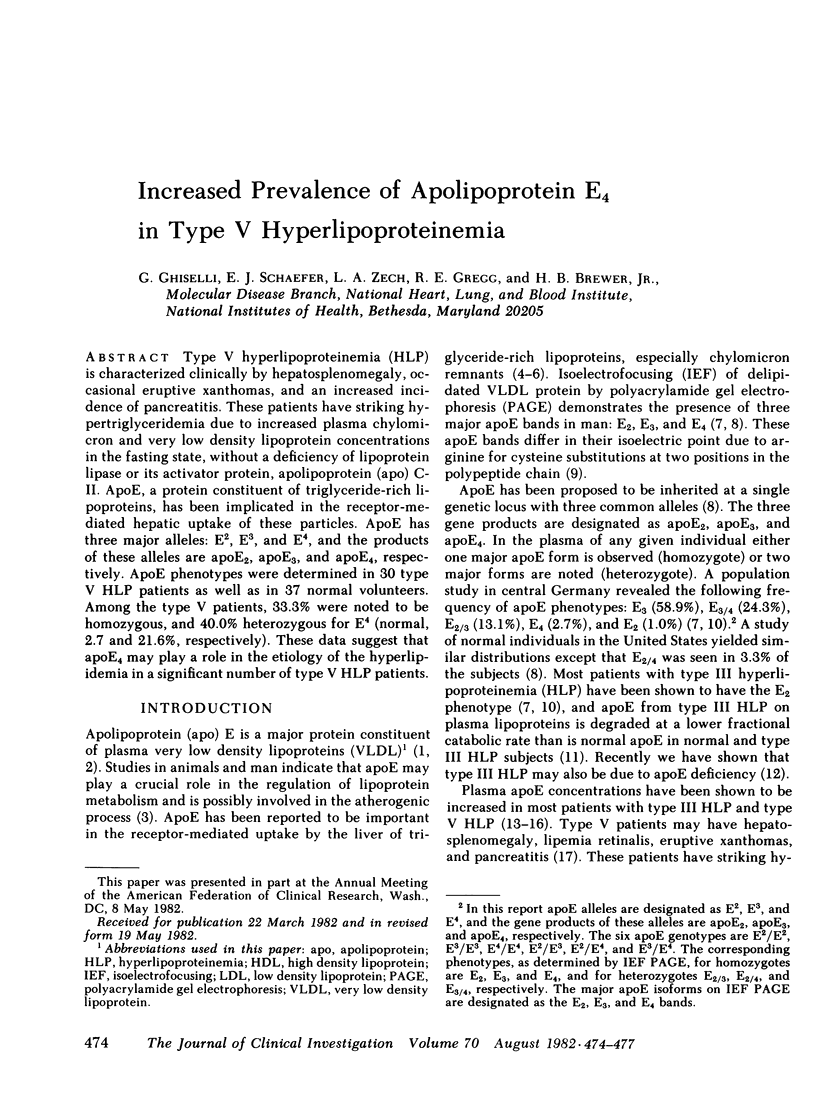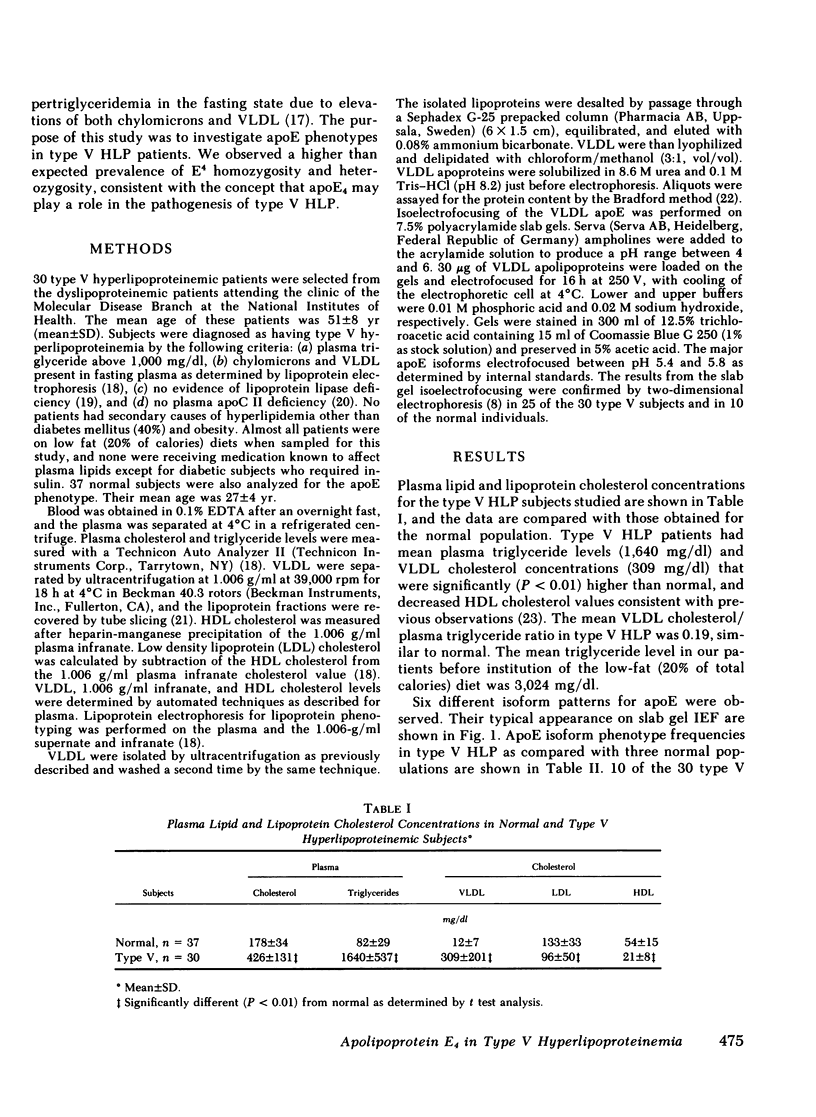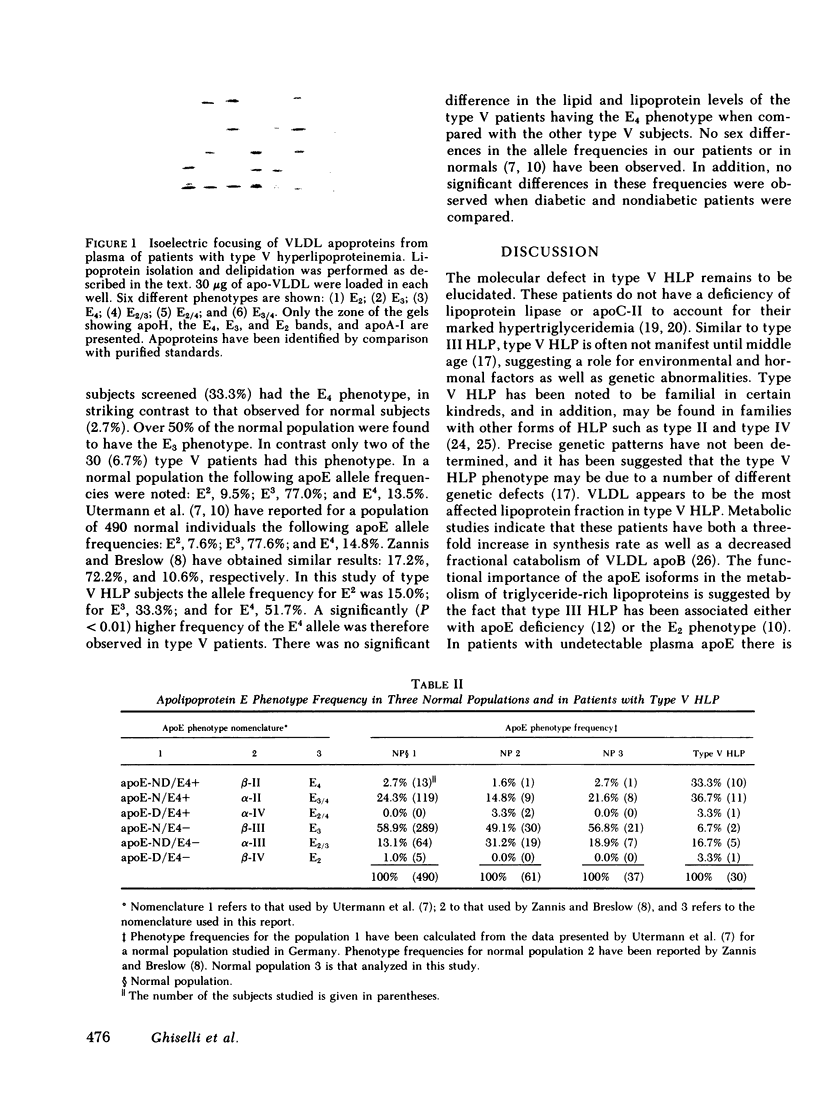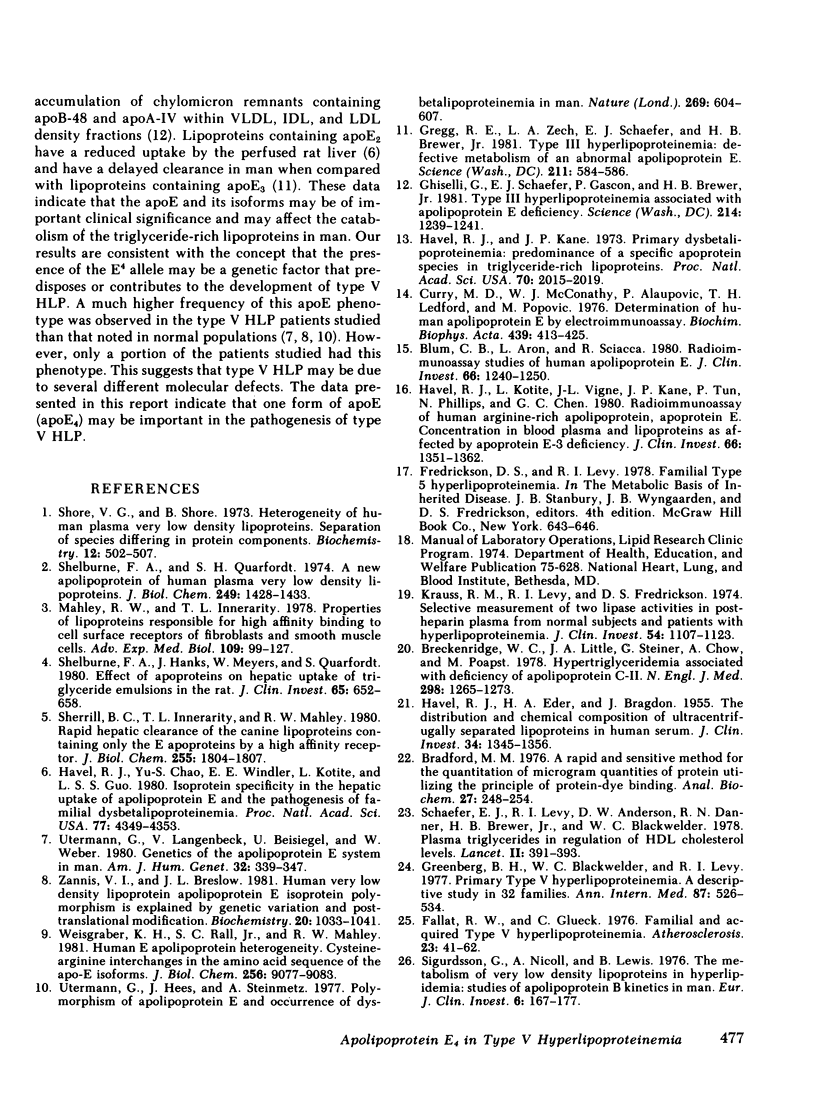Abstract
Type V hyperlipoproteinemia (HLP) is characterized clinically by hepatosplenomegaly, occasional eruptive xanthomas, and an increased incidence of pancreatitis. These patients have striking hypertriglyceridemia due to increased plasma chylomicron and very low density lipoprotein concentrations in the fasting state, without a deficiency of lipoprotein lipase or its activator protein, apolipoprotein (apo) C-II. ApoE, a protein constituent of triglyceride-rich lipoproteins, has been implicated in the receptor-mediated hepatic uptake of these particles. ApoE has three major alleles: E2, E3, and E4, and the products of these alleles are apoE2, apoE3, and apoE4, respectively. ApoE phenotypes were determined in 30 type V HLP patients as well as in 37 normal volunteers. Among the type V patients, 33.3% were noted to be homozygous, and 40.0% heterozygous for E4 (normal, 2.7 and 21.6%, respectively). These data suggest that apoE4 may play a role in the etiology of the hyperlipidemia in a significant number of type V HLP patients.
Full text
PDF



Images in this article
Selected References
These references are in PubMed. This may not be the complete list of references from this article.
- Blum C. B., Aron L., Sciacca R. Radioimmunoassay studies of human apolipoprotein E. J Clin Invest. 1980 Dec;66(6):1240–1250. doi: 10.1172/JCI109975. [DOI] [PMC free article] [PubMed] [Google Scholar]
- Bradford M. M. A rapid and sensitive method for the quantitation of microgram quantities of protein utilizing the principle of protein-dye binding. Anal Biochem. 1976 May 7;72:248–254. doi: 10.1016/0003-2697(76)90527-3. [DOI] [PubMed] [Google Scholar]
- Breckenridge W. C., Little J. A., Steiner G., Chow A., Poapst M. Hypertriglyceridemia associated with deficiency of apolipoprotein C-II. N Engl J Med. 1978 Jun 8;298(23):1265–1273. doi: 10.1056/NEJM197806082982301. [DOI] [PubMed] [Google Scholar]
- Curry M. D., McConathy W. J., Alaupovic P., Ledford J. H., Popović M. Determination of human apolipoprotein E by electroimmunoassay. Biochim Biophys Acta. 1976 Aug 9;439(2):413–425. doi: 10.1016/0005-2795(76)90078-7. [DOI] [PubMed] [Google Scholar]
- Fallat R. W., Glueck C. J. Familial and acquired type V hyperlipoproteinemia. Atherosclerosis. 1976 Jan-Feb;23(1):41–62. doi: 10.1016/0021-9150(76)90117-9. [DOI] [PubMed] [Google Scholar]
- Ghiselli G., Schaefer E. J., Gascon P., Breser H. B., Jr Type III hyperlipoproteinemia associated with apolipoprotein E deficiency. Science. 1981 Dec 11;214(4526):1239–1241. doi: 10.1126/science.6795720. [DOI] [PubMed] [Google Scholar]
- Greenberg B. H., Blackwelder W. C., Levy R. I. Primary type V hyperlipoproteinemia. A descriptive study in 32 families. Ann Intern Med. 1977 Nov;87(5):526–534. doi: 10.7326/0003-4819-87-5-526. [DOI] [PubMed] [Google Scholar]
- Gregg R. E., Zech L. A., Schaefer E. J., Brewer H. B., Jr Type III hyperlipoproteinemia: defective metabolism of an abnormal apolipoprotein E. Science. 1981 Feb 6;211(4482):584–586. doi: 10.1126/science.7455696. [DOI] [PubMed] [Google Scholar]
- HAVEL R. J., EDER H. A., BRAGDON J. H. The distribution and chemical composition of ultracentrifugally separated lipoproteins in human serum. J Clin Invest. 1955 Sep;34(9):1345–1353. doi: 10.1172/JCI103182. [DOI] [PMC free article] [PubMed] [Google Scholar]
- Havel R. J., Chao Y., Windler E. E., Kotite L., Guo L. S. Isoprotein specificity in the hepatic uptake of apolipoprotein E and the pathogenesis of familial dysbetalipoproteinemia. Proc Natl Acad Sci U S A. 1980 Jul;77(7):4349–4353. doi: 10.1073/pnas.77.7.4349. [DOI] [PMC free article] [PubMed] [Google Scholar]
- Havel R. J., Kane J. P. Primary dysbetalipoproteinemia: predominance of a specific apoprotein species in triglyceride-rich lipoproteins. Proc Natl Acad Sci U S A. 1973 Jul;70(7):2015–2019. doi: 10.1073/pnas.70.7.2015. [DOI] [PMC free article] [PubMed] [Google Scholar]
- Havel R. J., Kotite L., Vigne J. L., Kane J. P., Tun P., Phillips N., Chen G. C. Radioimmunoassay of human arginine-rich apolipoprotein, apoprotein E. Concentration in blood plasma and lipoproteins as affected by apoprotein E-3 deficiency. J Clin Invest. 1980 Dec;66(6):1351–1362. doi: 10.1172/JCI109988. [DOI] [PMC free article] [PubMed] [Google Scholar]
- Krauss R. M., Levy R. I., Fredrickson D. S. Selective measurement of two lipase activities in postheparin plasma from normal subjects and patients with hyperlipoproteinemia. J Clin Invest. 1974 Nov;54(5):1107–1124. doi: 10.1172/JCI107855. [DOI] [PMC free article] [PubMed] [Google Scholar]
- Mahley R. W., Innerarity T. L. Properties of lipoproteins responsible for high affinity binding to cell surface receptors of fibroblasts and smooth muscle cells. Adv Exp Med Biol. 1978;109:99–127. doi: 10.1007/978-1-4684-0967-3_6. [DOI] [PubMed] [Google Scholar]
- Schaefer E. J., Levy R. I., Anderson D. W., Danner R. N., Brewer H. B., Jr, Blackwelder W. C. Plasma-triglycerides in regulation of H.D.L.-cholesterol levels. Lancet. 1978 Aug 19;2(8086):391–393. doi: 10.1016/s0140-6736(78)91863-9. [DOI] [PubMed] [Google Scholar]
- Shelburne F. A., Quarfordt S. H. A new apoprotein of human plasma very low density lipoproteins. J Biol Chem. 1974 Mar 10;249(5):1428–1433. [PubMed] [Google Scholar]
- Shelburne F., Hanks J., Meyers W., Quarfordt S. Effect of apoproteins on hepatic uptake of triglyceride emulsions in the rat. J Clin Invest. 1980 Mar;65(3):652–658. doi: 10.1172/JCI109710. [DOI] [PMC free article] [PubMed] [Google Scholar]
- Sherrill B. C., Innerarity T. L., Mahley R. W. Rapid hepatic clearance of the canine lipoproteins containing only the E apoprotein by a high affinity receptor. Identity with the chylomicron remnant transport process. J Biol Chem. 1980 Mar 10;255(5):1804–1807. [PubMed] [Google Scholar]
- Shore V. G., Shore B. Heterogeneity of human plasma very low density lipoproteins. Separation of species differing in protein components. Biochemistry. 1973 Jan 30;12(3):502–507. doi: 10.1021/bi00727a022. [DOI] [PubMed] [Google Scholar]
- Sigurdsson G., Nicoll A., Lewis B. Metabolism of very low density lipoproteins in hyperlipidaemia: studies of apolipoprotein B kinetics in man. Eur J Clin Invest. 1976 Mar 31;6(2):167–177. doi: 10.1111/j.1365-2362.1976.tb00508.x. [DOI] [PubMed] [Google Scholar]
- Utermann G., Hees M., Steinmetz A. Polymorphism of apolipoprotein E and occurrence of dysbetalipoproteinaemia in man. Nature. 1977 Oct 13;269(5629):604–607. doi: 10.1038/269604a0. [DOI] [PubMed] [Google Scholar]
- Utermann G., Langenbeck U., Beisiegel U., Weber W. Genetics of the apolipoprotein E system in man. Am J Hum Genet. 1980 May;32(3):339–347. [PMC free article] [PubMed] [Google Scholar]
- Weisgraber K. H., Rall S. C., Jr, Mahley R. W. Human E apoprotein heterogeneity. Cysteine-arginine interchanges in the amino acid sequence of the apo-E isoforms. J Biol Chem. 1981 Sep 10;256(17):9077–9083. [PubMed] [Google Scholar]
- Zannis V. I., Breslow J. L. Human very low density lipoprotein apolipoprotein E isoprotein polymorphism is explained by genetic variation and posttranslational modification. Biochemistry. 1981 Feb 17;20(4):1033–1041. doi: 10.1021/bi00507a059. [DOI] [PubMed] [Google Scholar]



